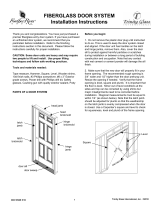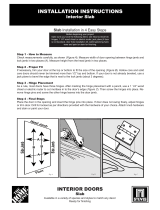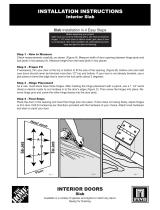
9
APPLICATION
There are many applications for interior doors, whether in a slab (door only) or pre-hung system.
Please remember to consider the following:
SLAB ONLY APPLICATIONS
Slab Replacement: When reusing an existing door frame and just replacing the interior door slab(s), use your
existing slab as a template for the door width and height required. Feather River Interior Door Slab(s) come with no
bore or hinge prep; you will need to mortise hinge locations and bore your own lockset hole using your current door
as a template. Feather River does not offer custom size doors. If trimming the door slab, it is imperative that you
follow the cut down guidelines listed below. Note: As with any slab replacement, your existing frame should be
plumb – square – and level.
Pocket Doors: When ordering a slab for a pocket door you will need to know the finished opening of the pocket
door frame as well as the maximum weight allowed for the pocket door hardware. Please refer to the average door
weights listed below.
Bi-Pass or Sliding Doors: When ordering slabs for a bi-pass or sliding door application, take the total finished
opening to determine the two door widths needed to fill the opening. Allow approximately " to 1" overlap
where the door slabs meet in the middle. It is also important to understand the recommended weight allowed for
the bi-pass or sliding door hardware to be used. Note: In most pocket door and bi-pass / sliding door applications,
the finished opening height should be at least 81" to 81" for an 80" slab, and 97" to 97" for a 96" slab.
Always refer to the pocket door and bi-pass / sliding door hardware manufacturer’s installation instructions to
determine the correct finished opening required, and what size slab can fit in the opening. Also understand Feather
River Interior Door cut-down limitations.
70-80 lbs
30-40 lbs
30-40 lbs
Crown Jewel Collection (96")
Diamond Carved Collection (96")
Texture, Theme, Privacy
& Natural Collections (96")
90-100 lbs
50-60 lbs
50-60 lbs
AVERAGE DOOR WEIGHTS
Crown Jewel Collection (80")
Diamond Carved Collection (80")
Texture, Theme, Privacy
& Natural Collections (80")
Note: All door weights are based on an oak slab with a 36" width.
CUT DOWN/TRIM GUIDELINES
If trimming is required in your application, please follow the maximum cut down specifications below:
Door Width: Maximum " each side, total width "
Door Height: Maximum " top & bottom, total height 1"
HOW TO MEASURE YOUR ROUGH OPENING
1. Between the studs, measure width at top, center, and bottom of opening.
Record the smallest measurement in the white box (rough opening only).
2. From floor up to the bottom of the header, measure height at both sides
of the opening. Record the smallest measurement in the white box (rough
opening only).
PRE-HUNG APPLICATIONS
In any pre-hung application, you must first determine your rough opening. This can be done by removing your
existing unit and following the “How To Measure” shown below. Another rule of thumb is to take the slab width
& height and do the following:
Flat Jamb Application: Flat jamb – consists of a flat jamb with door stop, door casing not included. When
measuring, add 2" to door slab width and height to determine rough opening. Note: For double door applications,
take the widths of the 2 door slabs + 2", and the height of the door slab + 2" to determine rough opening for a
double door unit with ball catches. For double doors with astragal, follow the same logic but add 2" to the
width measurement.
Split Jamb Application: Split jamb – is a 2 piece jamb where door casing is already applied to both sides, hinge side
of frame is installed (plumb–square–level) then other part of the frame is fitted into the installed frame and nailed in
place. When measuring, add 2" to door slab width and height to determine rough opening.
1. Record smallest
measurement
here:
2. Record smallest
measurement
here:
DOOR SPECIFICATIONS
Especificación de las puertas
featherriverdoors.com
Versión en español en la página 29.


























